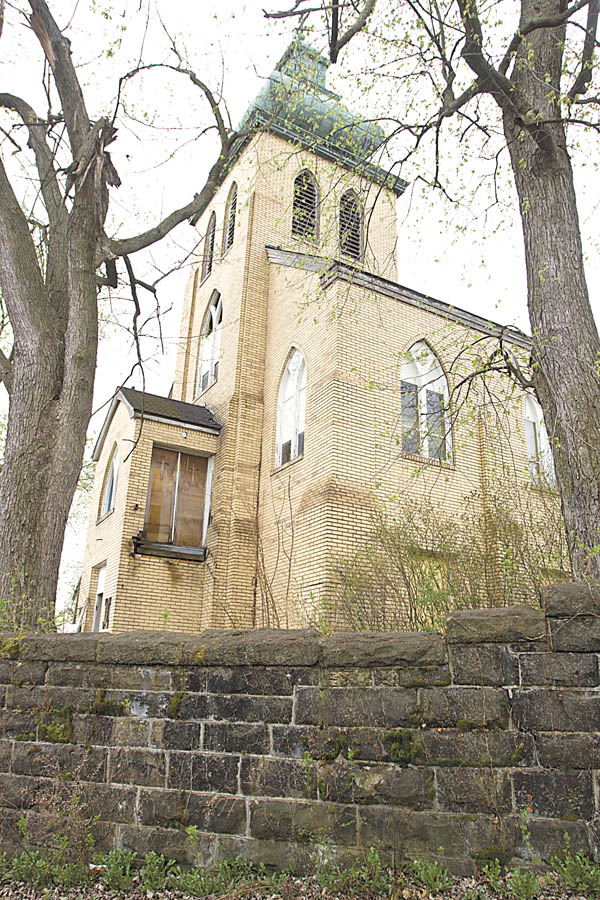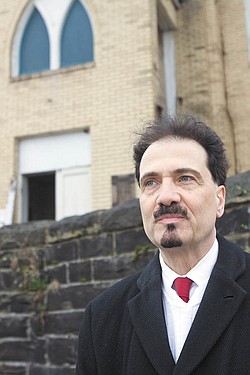Sacred sight
By LINDA M. LINONIS
YOUNGSTOWN
Richard Scarsella, historic-preservation promoter, is the man behind Sacred Places Dialogue, a movement about preserving or re-inventing places of worship. He’s standing in front of the closed St. Mary’s Byzantine Church on Salt Springs Road, Youngstown, which has housed various congregations. An individual now owns the building, which is in disrepair.

The side of the former St. Mary’s Byzantine Church at Florence Avenue and Salt Springs Road on Youngstown’s West Side. A local man is behind the Sacred Places Dialogue. The concept is based on a nationwide grass-roots movement on how to preserve sacred sites that once served as houses of worship and gathering places for ethnic groups.
SACRED PLACES DIALOGUE
- Richard Scarsella, president of the William Holmes McGuff ey Historical Society and a teacher at Chaney
- High School, is devoted to history and historic preservation. He’s behind Sacred Places Dialogue, which
- off ers ideas about fi nding new uses for places of worship.
- Purpose: To promote dialogue among interested parties concerning threatened or now closed denominational buildings on how to preserve and re-use religious structures based on historic value, demographics, economics, level of support, fundraising, authentic assessment and educational connections and other factors.
- Uses for the old structures: Museums of ethnic culture and artifacts; multipurpose social-service centers and neighborhood centers; youth, elderly and health-care centers; or inter- and intra-denominational use.
- For more information: Contact Scarsella at (330) 726-8277.
For Richard Scarsella, there is nothing more poignant than a closed house of worship.
“A closed church, synagogue or temple is even sadder than an abandoned school or shuttered theater. It leaves a vacuum which strikes at the heart and soul,” he said.
And because he’s acutely aware of how disuse ruins a closed worship site, Scarsella is the man behind Sacred Places Dialogue. The concept is based on a nationwide grass-roots movement on how to preserve or re- invent sacred sites that have served as houses of worship and gathering places for ethnic groups. The Diocese of Youngstown is considering closing several churches.
Scarcella has run ads in The Vindicator and elsewhere to offer his expertise to congregations facing the difficult decision of whether to merge or close.
As president of William Holmes McGuffey Historical Society and a member of various community boards, Scarsella readily admitted to an interest and passion about historic preservation.
“I see my role as a facilitator,” he said.
Scarsella has spoken with members representing diverse denominations about what to do with the building if the church closes.
Spending time in Boston while attending college gave Scarsella what he termed “heightened sensibility” about how a city turned history and historic preservation into a cottage industry. He also has traveled extensively in Europe, which also has capitalized on history.
“It’s my interest in history that’s not in history books,” he said of why he’s intrigued with worship sites that have played a dominant role in communities. He said churches have hosted ceremonies and shared experiences, food, music, celebrations and memorials that are preserved in the collective memory of residents.
He acknowledged that historical preser vation isn’t at the top of the list in these economic times. But, he noted, too often people rue the demolition day when a building or place that should have been saved wasn’t and is lost forever.
When the Mahoning Valley was booming with steel industries, the infrastructure was built.
“An outflow of young people seeking jobs elsewhere has left the infrastructure behind,” he said.
The number of people left can’t support the number of churches.
For their parents and grandparents, religious buildings often “anchored families, nationalities, neighborhoods and communities,” he said.
The buildings were more than a place to worship; they were gathering places for social and cultural events. Scarsella said churches are “examples of living history.”
People have celebrated, mourned and prayed at landmark spiritual sites in the community for centuries. They play a prominent role in memories of family occasions such as baptisms, weddings and funerals. And some, whose age alone puts them in a historic category, feature craftsmanship and materials of a bygone era.
The reasons why churches merge or close is a complicated mix of demographics.
“It’s a problem indicative of the times. ... Church attendance is down,” he said. “Young people have spiritual beliefs but aren’t involved in church.”
Young people aren’t as connected with history, he said.
And how each denomination handles the closing of church and its assets differs.
Scarsella said some worship sites lend themselves to other uses such as a museum of ethnic culture and artifacts. Those buildings would tend to be older, 100 years or more, and have special architectural details and craftsmanship.
Newer buildings could be turned into community centers or have multipurpose uses. Use may be dictated by “people’s comfort zones” and how they can accept a new purpose for the former church.
But, Scarsella said, tackling the process of preserving and re-inventing church buildings takes “unhurried discernment” and commitment to the task that will take much time and effort.
SEE ALSO: Calvary, West Side Baptist use merger approach to advantage
 43
43

